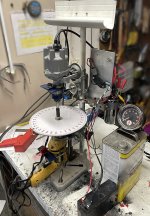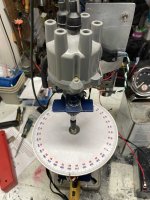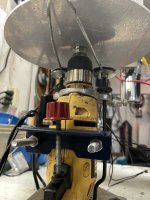I wrapped up my homebrew "distributor machine". I made it because I wanted to identify distributor (I'm running the DuraSpark II unit) mechanical advance curves without having to rev my car engine to values that could result in disaster if it slipped into gear or something. Nearly all of it is made from stuff I had here. I admit that it's not terribly aesthetic, but it does seem to work. I should also mention that although I had a general plan in mind, the majority of this was made up as I went along. So there are no plans or information other than photos and what I've written.
I had an old Sears "use-your-own-drill" drill press unit and used it as the foundation. I flipped the drill holder upside-down so the drill chuck was pointing up. I made sure that the drill I used was reversible and that it could run at a maximum of 2,000 rpm (equivalent to 4,000 engine rpm). I attached an angle iron bracket to the post that had been drilled and threaded. I used a piece of all-thread with a rubber foot on one end and a knob on the other end to allow me to depress and hold the speed trigger on the drill a certain amount.
I made a distributor holder out of a short length of 1-1/2 ID pipe. I cut and bent a piece of angle iron for the clamp base, welded a nut to the bottom for the clamp bolt to thread into, then welded that to the pipe that supports the distributor. I used another piece of angle iron for the hold down.
The degree wheel is a piece of aluminum plate that I cut using a circle jig on my bandsaw. I found a paper template with the numbers and markings on the web, sized it to my needs (9" diameter), printed it, sprayed it with clear Rustoleum, and glued it to the plate.
To drive the distributor, I cut a short length of 3/8" all-thread to chuck in the drill. It also holds the timing wheel. It connects to a short length of old distributor hex driveshaft with a piece of fuel line.
The ignition circuit is a Delphi unit wired into an old coil I had. I bought it, the distributor cap, the rotor, and the wires (I'd taken all my old wires to the recycler a couple of months ago). It's mounted on a piece of aluminum plate that's attached to the primary drill press post with some U-bolts.
I only need one spark plug wire coming out of the distributor cap (it doesn't matter which one since all the cylinders are advanced together). I have a sparkplug wedged and clamped into a piece of 1/2" pipe which in turn is clamped into another hole in the drill press casting.
I had a couple batteries from a UPS that I used to power the electronic (Delphi module, tach, timing light). I just made up wires with female spade terminals and ran them to the power switch.
It seems to work pretty well. I had hoped to use my old Sears "Engine Analyzer" since it has a large, easy-to-read tach. Unfortunately, that tach flakes out at anything over 3000 rpm. I'm assuming that it's something to do with the electronic ignition. So I'm using another old tach that used to be in my car. It's smaller but works to the full 4,000 rpm.
To use the rig, I start at a low rpm and use the timing light to see where the pointer falls on the wheel. If it's not on a major mark (for example, 70), I rotate the distributor a little to get it on a major mark. Once I have that set up, it's just a matter of increasing the drill speed incrementally, reading and logging the degrees on the wheel and the indicated rpm. Easy-peasy.
I think I've spent around $50 for parts - the Delphi module, some connectors, the cap and rotor, the ignition wires and a few bits of hardware like the U-bolts. Other than that, everything came from the stuff I had laying around.
I should also mention that I've not noticed any adverse impacts of using it - no time travel, no portals opening to evil demon universes, ...
Wanted to share



I had an old Sears "use-your-own-drill" drill press unit and used it as the foundation. I flipped the drill holder upside-down so the drill chuck was pointing up. I made sure that the drill I used was reversible and that it could run at a maximum of 2,000 rpm (equivalent to 4,000 engine rpm). I attached an angle iron bracket to the post that had been drilled and threaded. I used a piece of all-thread with a rubber foot on one end and a knob on the other end to allow me to depress and hold the speed trigger on the drill a certain amount.
I made a distributor holder out of a short length of 1-1/2 ID pipe. I cut and bent a piece of angle iron for the clamp base, welded a nut to the bottom for the clamp bolt to thread into, then welded that to the pipe that supports the distributor. I used another piece of angle iron for the hold down.
The degree wheel is a piece of aluminum plate that I cut using a circle jig on my bandsaw. I found a paper template with the numbers and markings on the web, sized it to my needs (9" diameter), printed it, sprayed it with clear Rustoleum, and glued it to the plate.
To drive the distributor, I cut a short length of 3/8" all-thread to chuck in the drill. It also holds the timing wheel. It connects to a short length of old distributor hex driveshaft with a piece of fuel line.
The ignition circuit is a Delphi unit wired into an old coil I had. I bought it, the distributor cap, the rotor, and the wires (I'd taken all my old wires to the recycler a couple of months ago). It's mounted on a piece of aluminum plate that's attached to the primary drill press post with some U-bolts.
I only need one spark plug wire coming out of the distributor cap (it doesn't matter which one since all the cylinders are advanced together). I have a sparkplug wedged and clamped into a piece of 1/2" pipe which in turn is clamped into another hole in the drill press casting.
I had a couple batteries from a UPS that I used to power the electronic (Delphi module, tach, timing light). I just made up wires with female spade terminals and ran them to the power switch.
It seems to work pretty well. I had hoped to use my old Sears "Engine Analyzer" since it has a large, easy-to-read tach. Unfortunately, that tach flakes out at anything over 3000 rpm. I'm assuming that it's something to do with the electronic ignition. So I'm using another old tach that used to be in my car. It's smaller but works to the full 4,000 rpm.
To use the rig, I start at a low rpm and use the timing light to see where the pointer falls on the wheel. If it's not on a major mark (for example, 70), I rotate the distributor a little to get it on a major mark. Once I have that set up, it's just a matter of increasing the drill speed incrementally, reading and logging the degrees on the wheel and the indicated rpm. Easy-peasy.
I think I've spent around $50 for parts - the Delphi module, some connectors, the cap and rotor, the ignition wires and a few bits of hardware like the U-bolts. Other than that, everything came from the stuff I had laying around.
I should also mention that I've not noticed any adverse impacts of using it - no time travel, no portals opening to evil demon universes, ...
Wanted to share




